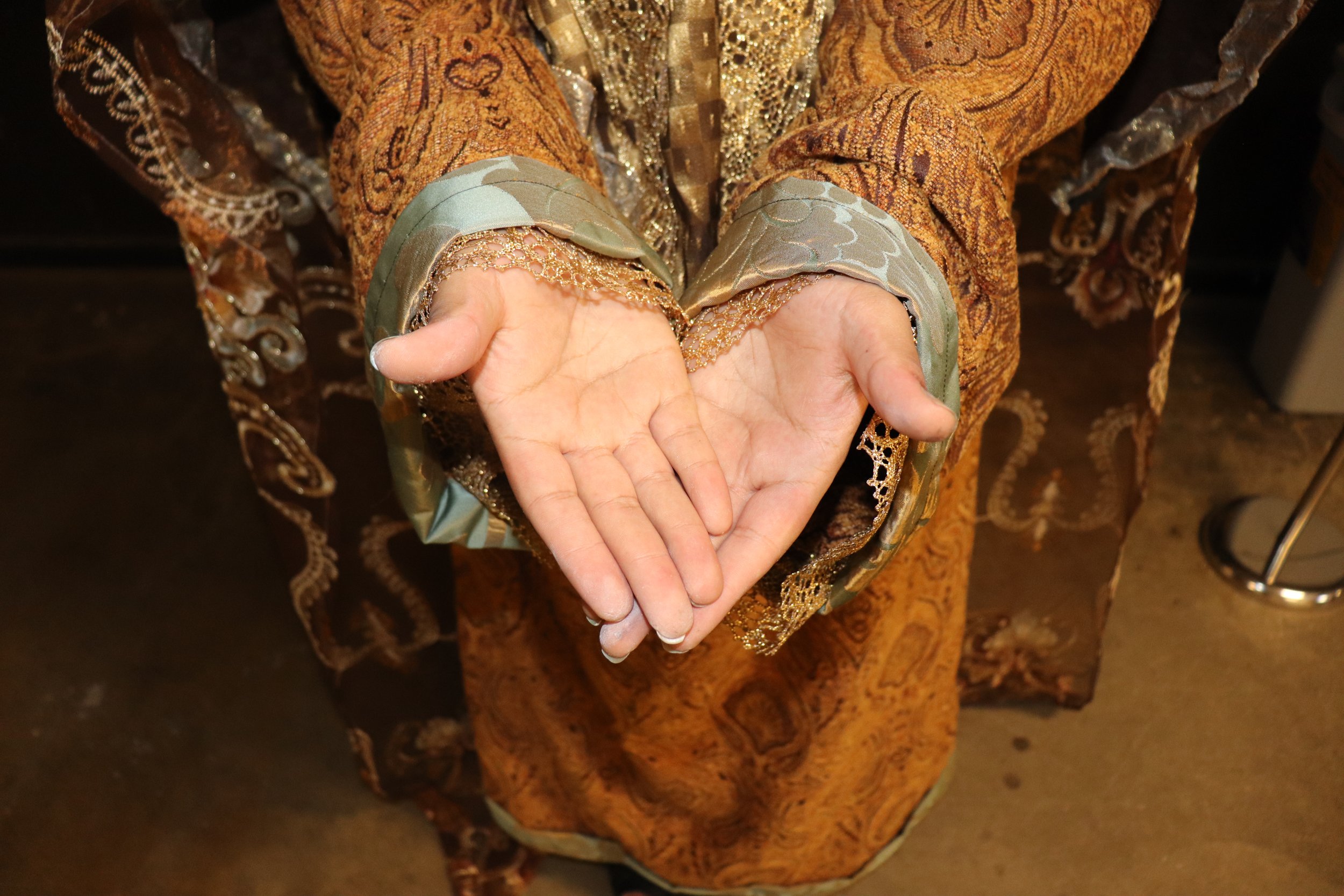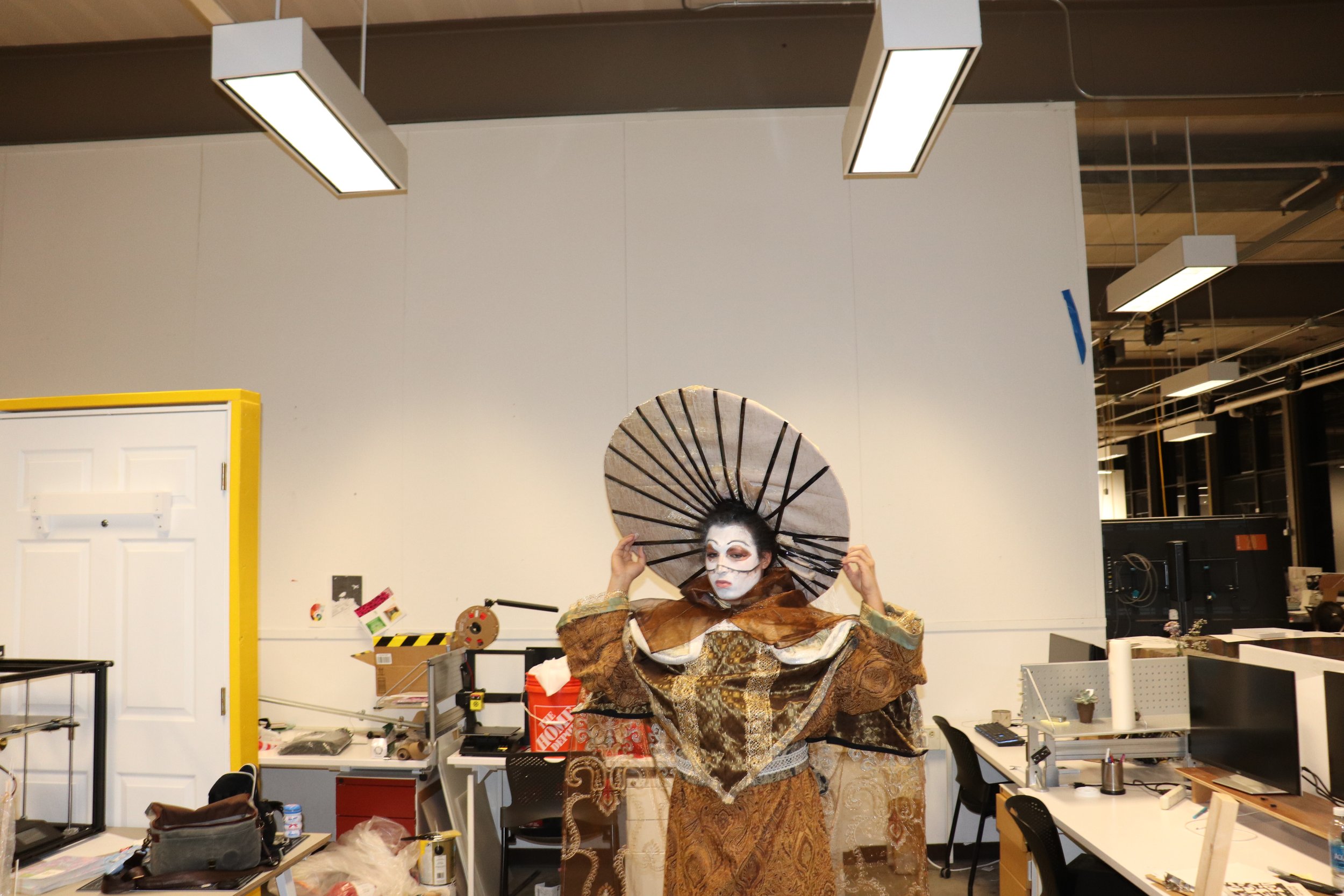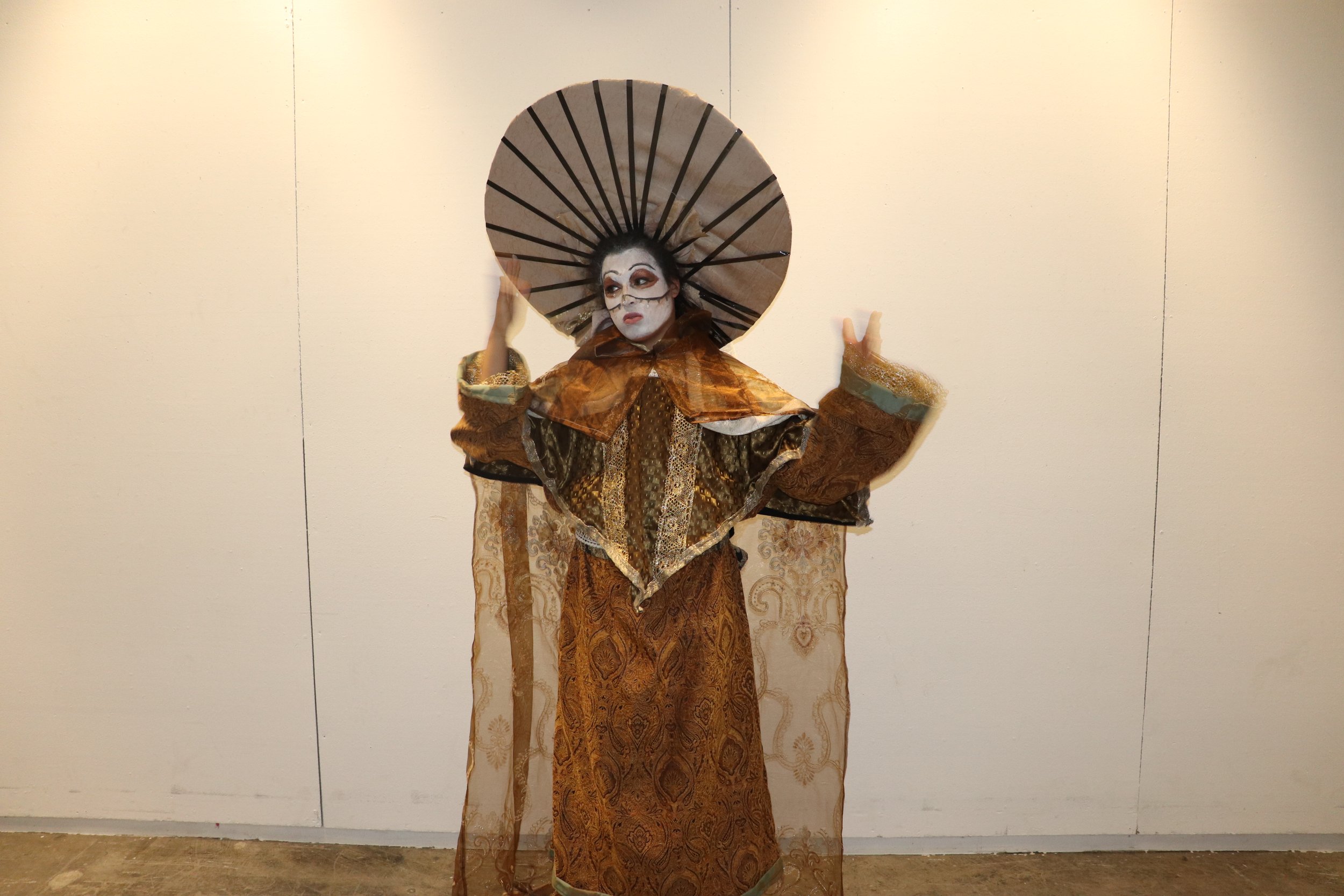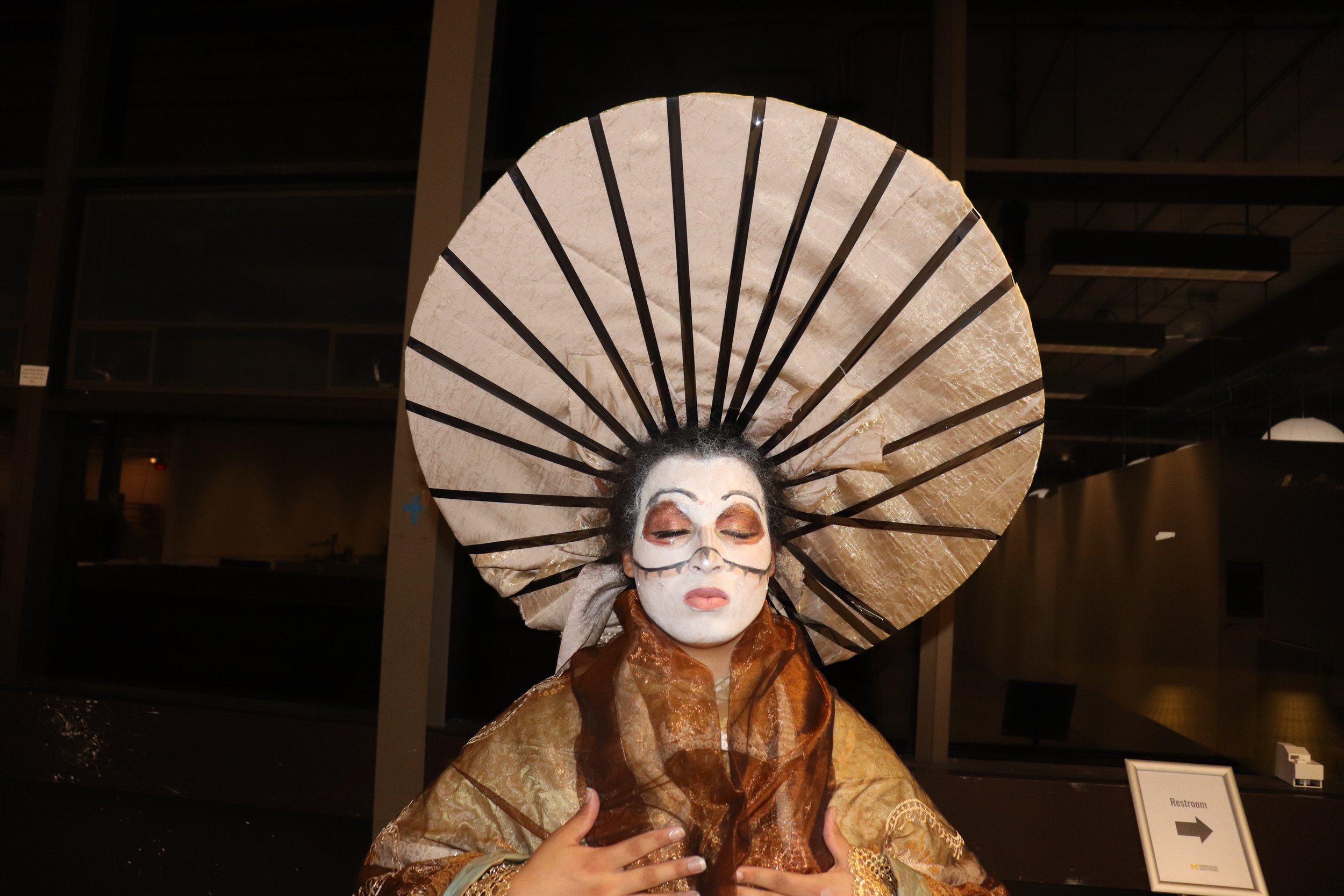
Initially, the aim of the final presentation was to showcase how the baroque styling manifested in Drag Aesthetics around the world, and to an extent it still is, though it has since coalesced more into the usage of Drag Aesthetics and Sensibilities to manufacture a set of garments that best capture the ostentatiousness characteristic of the Baroque. Throughout the process of making I was keen on maintaining the sense of thrifty resourcefulness that is often utilized in Drag and Ballroom garmenture, and in doing so I not only developed a keener sense for material quality, but I also refined a selection criteria that relied on material behavior and movement for the eventual products. With each fabric, ribbon, trim, and pattern procured, I would be one step closer to a set of items that would essentially be an analogue for wearing a Baroque Church on my body. Going hand-in-hand with my Thesis subjects, the Sisters of Perpetual Indulgence, an areligious grouping of Drag Activist “Nuns” who co-opt church motifs and vestments to subvert the expectations and associations with the church, I wanted this set of wearables to invoke a similar set of subversive elements, allowing the clothes of this imagined clergy to speak as loudly if not more loudly than the marvelous churches they may already find themselves in.















This will be a detailed breakdown of each part of the ensemble, as if I were a foreman detailing the workings, pipes, coursework, and moldings of a building, because what is couture and garment making if not cladding the body with wearable walls, floors, ceilings, and ornament to best convey a material message. Beginning with accessories there were two elements that I felt may help in bringing about the feeling of being part of a church procession - bells and blood. In one hand I held three 4-inch radius metal hoops, usually used for macrame and wreath making, that when jostled around by walking would clang together reminiscent of church bells in towers signaling the start of service. In the other hand, bound in a loop lest it slip from my grasp was a strip of liquid gold silk blend organza - a fabric that would have otherwise served as a table runner or the lining of a gift box, shimmering and loose, capable of mimicking the fluidity of water, yet thicker, the perfect representation of golden blood flowing from my hand onto the ground. Rounding out the accessories of the outfit, both figuratively and literally is the halo/veil worn on the back of my head. This was something I had immense pleasure in making a reality, having seen something similar in pride parades worn by members of the Sisters of Perpetual Indulgence. The corona was made from a large round of cardboard, with a smaller round cut off-center in order to have the top and sides flank the head, with another metal hoop on the inside to maintain shape. The round was then wrapped in a special lavender and gold fabric which caught the light when put in motion and secured in place by VHS film, wrapped from the inner circle to the outer circle in a sunburst pattern meant to be reflective and to emulate the rays of salvation and enlightenment off of the heads of holy figures in liturgical depictions. The veil, a simple lace trim was wrapped around my hair and secured under my hair tie to ensure a drawing effect down my back with the halo resting on my ponytail.














Moving from accessories onto the first of many layers of garments, we get to the outermost cloak. This was one of the few pieces I did not seek to alter partially due to the exquisite piping already present on the material, with sequins, gold thread, and an ornate flowering pattern present to begin with. This was initially a semi-transparent brown-bronze organza sun curtain with a scalloped base. The material, with its billowing quality and ability to be light and see-through, made it the perfect overcoat choice, with a simple button stitch securing it around my neck to serve as a brilliant flowing cape. The elevation of mundane items like sun shades and curtains was everywhere in this project, with special emphasis placed on keeping patterns and pre-existing handiwork at the forefront of the designs.
Just below the cloak are a pair of items that act in an almost superfluous way, not unintentionally, with the simple act of “a hat on a hat” being one of the guiding principles of queer extravagance and camp. In this case, it is actually a cape on a cape, or a throw on a poncho, or to be most specific, a clerical shoulder cape on a priestly chasuble. Each of the pieces may be worn independently, bringing with them a flare of ornate sensibility that may otherwise remain understated. Starting with the smaller of the two, the shoulder cape is a recognizable feature of clergymen’s attire, but rather than being a simple addition of black serge material with silken trim, as would be the usual affair, this item prides itself on being much more overstated. With an off-olive green gold and white paisley-esque pattern adorning the top, the cape is also reversible. The underside being a dark teal silken fabric with bronze leaves that catch light as well, with a shimmering white trim around the entire cape that puffs the edges and allows for a regalness to be felt even when detached from the complete ensemble. This decision to make a second cape came from its associations with clerics in classic RPG settings, fighters who still maintain and rely on religious convictions to contribute to the play. The chasuble, likewise, has deep religious significance, worn by priests atop their robes and often exhibiting their own extremely ornate and decorative elements like embroidery, brocade, and needlework. In this instance, it was a culmination of many design choices that made its additive nature yet more apparent. Not only is there ribbon trim along the borders of the piece but also framing the front and back designs, including some lace trim on the collar border to hammer home the churrigueresque nature of certain baroque constructs. It was never a question of taking things away from the final product but rather what could be added yet still to make the piece that much more compelling. Like the shoulder cape before it, the chasuble also takes advantage of wearable variance by having a front and back design that are drastically different, with orange-golden ornate elements stitched together to somewhat continue the elements of the robe below.



















The final and arguably most vital part of the outfit is that of the priestly robe, complete with a cinching belt to give form. The belt, made from heavy brocade black and gold curtains was also bedecked in a particular trim of ribbon that combined both lace and sequins so that even the most mundane of strips of cloth, only there to serve as a tie for a greater garment, could serve to shine in a manner like unique crown molding within church contexts. The robe, despite being the basal form for this outfit to take shape around, was actually produced last, because I wanted to know what the base needed to serve as after all was said and done, and in that way, the vision was clearer than some of the other items. Utilizing several sheets of a brocade orange, brown, and gold curtain set, I produced a standard over-the-head church robe, with long sleeves and a golden carpeted circular robe collar. What was most significant to the development of this concept was actually the sleeves of the piece, because even in reading about the lived realities of the clergy, both nuns and monks, I realized that the adage of “idle hands being the devil’s playthings” was not just poking fun, but a held belief, which is why many a conventional figure would go about their business with their hands clasped or even obscured by great sleeves. In constructing them I wanted to ensure that even in a closed position they allowed a sense of whimsy to poke through, both in terms of border trim and peeking ribbon. The sleeves are trimmed (as is the hem of the robe) with the same teal and gold leaf of the shoulder cape, and the ribbon that sits behind the folded sleeves is one of gold lace, adding an over the top element that brings the experience to a head.
Everything comes down to the Details - Turning the Heavily Discarded to the Highly Regarded
The overdoing and embellishing of basic and forgotten fabrics into something greater than the sum of its parts is something incredibly reminiscent of drag itself, elevating thrifted materials and imbuing certain articles with a sense of significance they might not have otherwise. The curtains that would eventually become the robe were well-loved, having been sun-bleached on their underside, and to give that fabric a second life was a kindness I was happy to extend
This set of clothing was made to imitate and bring forth more queer readings of the fabrics through their stylings and exaggerations, and while the baroque itself was only retroactively considered feminine, I wanted to further explore the way in which drag artists took that reading of this school of doing and made it their own. I made decisions that were purposely guided by the principles of camp and in doing so made a reminiscent neo-baroque, layered wearable image of a church. In the projects I uptake, I desire to highlight queerness and ingenuity in sustainable practice and I feel as though this set of garments does that tenfold. Here are a few extra images to see the set in its entirety.









